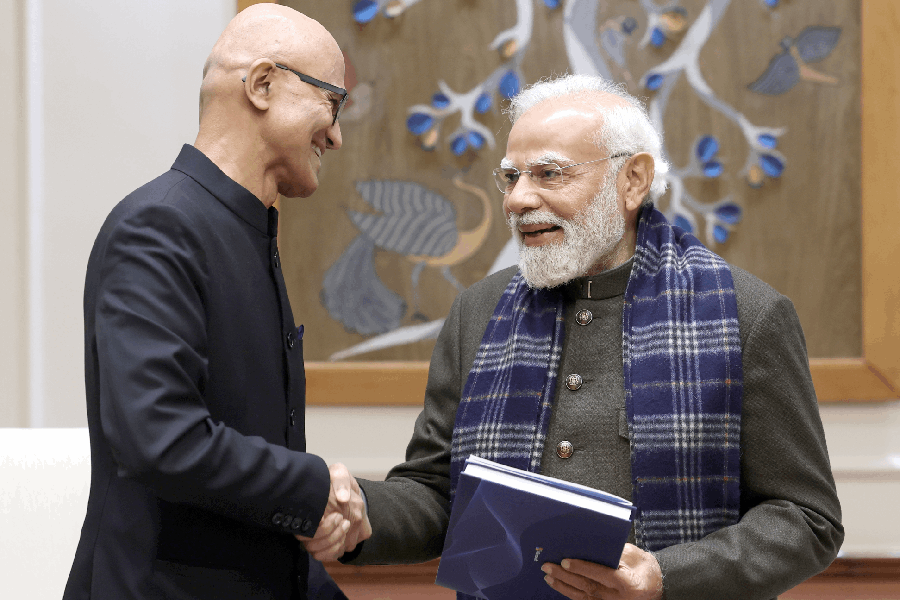 |
| An old photograph of PM Bagchi & Co. and (below) rubber stamps made by the company. Picture by Shubha Bhattacharjee |
 |
The name Gulu Ostagar Lane suggests the presence of master tailors or ostagars, as they were called. Gulu and Lal (a neighbouring lane was once named after him) were tailors of the family of Raja Nabakrishna Deb of Sovabazar. But one of the most famous names in this area, popularly known as Darjipara, is that of PM Bagchi Company that has been bringing out almanacs in Bengali for a century and more. The Bagchi family residence that stands next to the printing press is on Masjid Bari Street.
The office of the company is housed inside a single-storeyed wooden structure with a tiled roof, and it stretches from one end of the property to the other. The spacious office of two of the directors is inside this structure with a high ceiling. A porcelain lampshade once used to hang above the secretariat table. Now only the pulley of electric wire with which one could lower the lamp hangs from the ceiling.
The glass panes are grimy. The dusty cupboards and shelves are loaded with books. The large framed photographs on the walls are of the progenitors of this family originally from Shantipur in Nadia district. One of them wears headgear and robes harking back to the times of Bankim Chandra Chattopadhyay.
The company was established in 1883 by Kishorimohan Bagchi, son of Piyari Mohan. The establishment, which initially produced writing ink, derives its name from the latter’s initials. Subsequently, it diversified — from toiletries to rubber stamps, which in no time were much in demand in the market.
In those days, one of the most important means of promoting consumer products was through advertisements in almanacs, which were a must in all Hindu families.
In the beginning, Kishorimohan used to advertise his products in the almanacs available in those times, till he started publishing one himself. Initially, he used to get it printed elsewhere. Later he started his own press, and launched a publishing division at the same time. In between publishing the almanac, books began to be produced. Besides books on religion, novels, satirical compositions, and pennydreadfuls made it to his list of publications. A Bengali-to-English dictionary, Harisadhan Mukhopadhyay’s Kalikata Sekaler O Ekaler and translations of Bankim’s Kapalkundala, Les Miserables and other works were also among his publications.
As the toiletries — hair oil and perfumes — became even more popular, fakes began to appear in the market. To stop this Kishorimohan began to get his labels printed in Germany, which were impossible to replicate in India.
P.M. Bagchi’s almanac or panjika first appeared in 1888, but some other almanacs had already hit the market. To make his almanac more attractive he packed it with information that could be useful to people. The value addition was amazing for any time. He included a diary, advertisements, the 51 holy spots, where, according to legend, the body parts of Sati or Durga were cast, and famous places for pilgrimage, measurements and weights, legal matters such as advocate’s and court fee, income tax, rate of taxation, detailed information regarding post and telegraph, a list of all post offices in India and postal charges in the country and abroad, succession laws, examples of correspondence in English and Bengali, treatments of minor ailments, homoeopathic medicines, retail markets; a list of all the newspapers in undivided India, Burma and Ceylon, and of all government officials, high court adjudicators; and the famous street directory — a listing of all addresses, residents and their professions.
Besides, there was a list of offices, hospitals, education departments, judges, advocates and much else. The information was updated every year.
One of the company’s directors, Jayanta Bagchi, is updating the section of the Calcutta street directory, which is to be published soon.
The company expanded owing to Kishorimohan’s efforts. He started a type foundry as the types available in the market were not of a high quality. He began to produce printing ink and rollers.
Whenever Kishorimohan faced any problem procuring something, he produced it himself. He died at 55, bequeathing shares of the company to his brothers as it was named after their father.
By that time PM Bagchi & Company had offices in Mumbai, Patna, and Guwahati. Jayanta Bagchi recalls that as a child he had seen a promotional film made in colour by the artist Mandar Mallik. It was an animated film and promoted P.M. Bagchi’s writing ink.
The company continues to publish the almanac, besides Srimat Bhagabat Geeta, Purohit Darpan and other books. It still has a handpress and a pre-World War II Platen printing machine of the brandname Phoenix. However, with the younger generation of Bagchis being indifferent to the family business, P.M. Bagchi’s future is uncertain.










